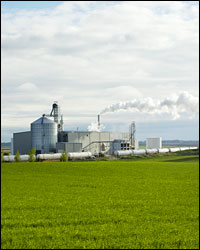As ethanol boosterism spreads far and wide — from Bush’s bully pulpit to the New York Times to green-group press releases — a quietly emerging trend is threatening to undermine the biofuel’s environmental credibility. editorial page

How green is this ethanol plant?
Photo: iStockphoto.
More and more ethanol manufacturers are looking to power their plants with cheap coal instead of its cleaner and increasingly expensive competitor, natural gas, thereby potentially limiting ethanol’s environmental benefits. And the Bush administration is doing its part to accelerate this trend. Under pressure from a group of senators and representatives from corn- and coal-producing states, the U.S. EPA is considering a rule change under the Clean Air Act that would relax pollution regulations on ethanol plants, clearing the way for them to burn coal with fewer restraints.
While only four of roughly 100 ethanol plants currently operating in the U.S. are powered by coal (practically all of the rest are fueled by natural gas), some 190 more are under construction or soon to be built. One energy analyst, Robert McIlvaine, president of the Illinois-based research group McIlvaine Company, predicts that “100 percent” of new ethanol plants built in the U.S. over the next few years will be coal-fired, “largely because of the exorbitant cost of natural gas right now, and the comparatively predictable future supply of homegrown coal.” A recent article in the Christian Science Monitor also points out that many ethanol manufacturers are increasingly being drawn toward coal.
But Nathanael Greene, a renewable-energy expert with Natural Resources Defense Council, doesn’t see such a clear-cut trend. “Less than a quarter of the 16-plus ethanol plants that came online last year were coal-fired, even given current natural-gas prices,” he says. He believes that many ethanol-industry leaders will stick with natural gas or opt for zero-emission renewable fuel sources for their plants in order to protect their much-advertised eco-friendly image and avoid the arduous environmental-review process required for coal-plant construction.
Still, some enviros see cause to worry about a tilt toward coal, particularly because ethanol production in the U.S. is already fossil-fuel intensive. Nearly all of the ethanol on the U.S. market today is derived from corn, which tends to require substantial fossil-fuel inputs to grow, harvest, and process. While the eco-utopian promise of cellulosic ethanol — derived from substances such as switchgrass and woodchips that require comparatively negligible fossil-fuel inputs — lingers on the horizon, cellulosic technology is still in its infancy, years away from widespread use.
According to recent research on ethanol’s environmental benefits from the University of California at Berkeley, corn-derived ethanol produced by a natural-gas powered plant offers a 38 percent greenhouse-gas reduction compared to gasoline, while corn-derived ethanol produced by a coal-fired plant offers a greenhouse-gas benefit of only about 19 percent. Cellulosic ethanol, by comparison, is far more conducive to processing without any fossil fuels, and thus is expected to offer an 88 percent reduction in greenhouse-gas emissions compared to gasoline.
Greene estimates that an ethanol industry using environmentally preferable production methods could fully replace the gasoline used in America by mid-century and slash U.S. greenhouse-gas emissions by 1.7 million tons per year, equivalent to 80 percent of current greenhouse-gas emissions from transportation.
Not Ethanol It’s Cracked Up to Be
Instead of striving to produce the cleanest, greenest ethanol, however, many in the industry want to keep production costs as low as possible, and they’re supported by members of Congress who also want to use ethanol’s soaring popularity to bolster the coal industry.
In March, the EPA — reportedly at the behest of at least one corn-state politician — proposed changing a rule in order to let ethanol-fuel plants more than double their air emissions, from 100 tons per year of any pollutant regulated under the Clean Air Act to 250 tons per year.
“This proposal is clearly designed to usher in this wave of new coal-fired plants — loosening the rules so that the facilities can be bigger, dirtier, and cheaper,” says Greene’s colleague John Walke, director of NRDC’s clean-air program. Walke warns that if the EPA approves it, his group might file suit. While ethanol-fuel manufacturers can build coal-fired plants under current rules, the facilities have to be kept relatively small to meet pollution restrictions, and must undergo a rigorous permitting process.
On the other hand, a bipartisan group of 33 members of Congress led by Sen. John Thune (R-S.D.) threw its support behind the proposed rule change earlier this month in a letter [PDF] to EPA Administrator Stephen Johnson. The Renewable Fuels Association, an industry trade group, also backs the change.
A public-comment period on the proposal concluded earlier this month, and a final decision is expected soon. “It’s widely accepted that the EPA will go ahead and make this important change,” says Matthew Hartwig of RFA.
According to Kyle Downey, a spokesperson for Thune, “The current rules are needlessly impeding the growth of ethanol nationwide.” He further argues that the trend toward coal is a good thing for the planet in the long run because it will accelerate the development of ethanol-friendly infrastructure, thereby paving the way for a system based on cellulosic ethanol: “The cheaper the ethanol in the short term, the greater the consumer demand will be for a shift from gas to ethanol, and the quicker America will transform fueling stations from gasoline to ethanol,” he says, suggesting that the industry could then gradually move toward lower-emission forms of ethanol.
Environmentalists reject this logic, arguing that the ethanol industry is booming now and doesn’t need looser environmental regulations to succeed. “The ethanol markets are already exploding with 25 percent growth per year without this rule change,” says Greene. “The industry is expected to double in less than four years. It’s very clear that there is an economically viable way of growing the ethanol industry rapidly without sacrificing public health.”
He points to new corn-ethanol facilities fueled by zero-emission technologies. A plant in Nebraska was built next to a cattle farm so it could use methane from the bovine waste to power its operations. Two others in Minnesota use fuel from gasified biomass, and a demonstration plant being built in Illinois will be powered by solar thermal collectors. These facilities can produce corn ethanol with nearly 70 percent lower greenhouse-gas emissions than gasoline, says Greene. “I suspect we’ll see substantial growth in this area,” he predicts.
RFA’s Hartwig agrees that zero-emission ethanol plants are economically sound and part of an important trend; still, he sees them as only one part of the puzzle. “We need a diversified approach to growing this industry,” he says. “There is plenty of room for coal, natural gas, and renewables.”
But if the industry wants to keep promoting ethanol as the eco-friendly fuel of the future, it would be well advised to lay off the coal and lean on clean energy.


